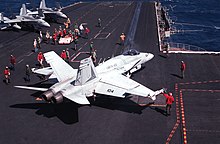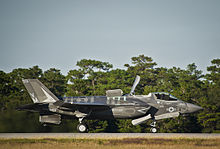VMFAT-501
| Marine Fighter Attack Training Squadron 501 | |
|---|---|
 VMFAT-501 insignia | |
| Active | 15 February 1944 – 10 September 1945 1 July 1946 - 31 January 1997 1 April 2010 - present |
| Country | |
| Branch | |
| Type | Attack |
| Role | Close air support Air interdiction Aerial reconnaissance |
| Part of | Marine Aircraft Group 31 2nd Marine Aircraft Wing |
| Nickname(s) | "Warlords" "Blue Devils" "Fightin Phillies" |
| Motto(s) | "Vini Vici" |
| Tail Code | BM / VM |
| Engagements | |
| Commanders | |
| Commanding Officer | LtCol Zachary M. Baskara |
| Executive Officer | LtCol Matthew A. Sisneros |
| Aircraft flown | |
| Fighter | F4U-1D Corsair F6F-5 Hellcat F9F-2 Panther FJ-2/4 Fury F-8 Crusader F-4J Phantom II F/A-18A Hornet F-35B Lightning II |
Marine Fighter Attack Training Squadron 501(VMFAT-501) is a training squadron in theUnited States Marine Corps,consisting of 27F-35B Lightning IIaircraft and serves as theFleet Replacement Squadron.Known as the "Warlords," the squadron is based atMarine Corps Air Station Beaufort,South Carolinaand falls administratively underMarine Aircraft Group 31and the2nd Marine Aircraft Wing.The squadron has assumed the lineage ofVMFA-451which was originally known as the "Blue Devils" and saw action duringWorld War IIandOperation Desert Storm.They were decommissioned on 31 January 1997.
History
[edit]World War II
[edit]Marine Fighting Squadron 451 (VMF-451) was activated on 15 February 1944 atMarine Corps Air Station Mojave,California.The "Blue Devils" were one of 32 squadrons that trained at the base, and were collectively known as the "Mojave Marines". Equipped with the Chance-VoughtF4U-1D Corsair,they spent nearly a year training for carrier-based operations under the command of Major Henry A. Ellis Jr., who remained the Commanding Officer for 17 months.[1]
The squadron moved on boardUSSBunker Hill(CV-17)on 24 January 1945, along withVF-84andVMF-221.This was the first fast-carrier deployment with three Corsair squadrons. As a new member of CVG-84, collectively known as the "Wolf Gang", CV-17 sailed westward across the Pacific. They flew their first combat sorties on 16 February, against targets nearTokyo.The "Blue Devils" scored their first kill during the initial combat mission, but also suffered their first casualty. Lieutenant Forrest P. Brown was shot down by anti-aircraft fire, and was last seen floating in the water. On 18 March, they focused their fury on Kyushu, destroying the Myazaki and Omura air fields and bagging another kill. On 3 April, the "Blue Devils" had a field day in knocking down 11 Japanese planes, and on 12 April, they brought down 16 kamikazes. MajorArchie Donahue,the XO, shot down three Vals and two Zekes, thus becoming the first carrier-based Marine "ace-in-a-day" and adding to the nine previous kills that he scored withVMF-112in 1943. 11 May was pivotal for VMF-451 and the other "Wolf Gang" members of Bunker Hill. It started on a positive note, as First Lieutenant J.S. Norris Jr. shot down a Zeke near Amami, bringing VMF-451's score to 34 confirmed kills. At 1005 hours, Bunker Hill was struck by two kamikazes, each carrying a bomb that was released prior to impact. Bunker Hill immediately began to burn and the smoke attracted more kamikazes. However, none of the suicide planes were able to penetrate the flak, and Bunker Hill was spared any more hits. The flames were eventually extinguished and CV-17 limped back to Ulithi, thenPearl Harbor,and finally arrived for battle-damage repair atPuget Sound,Washington,on 3 June 1945. VMF-451 rejoined the ground echelon atMarine Corps Air Station El Toroto remain until the end of the war. They earned aPresidential Unit Citationfor their efforts in theJapan,Bonins and Ryukyus campaigns, and were deactivated on 10 September 1945.
1950s
[edit]
On 1 July 1946, the "Fightin’ Phillies" were reactivated as a reserve unit atNaval Air Station Willow Grove,Pennsylvania,equipped with the GrummanF6F-5 Hellcat.They remained as a reserve squadron untilhostilitiesbroke out inKorea.On 1 March 1951, the unit was recalled to active duty and equipped with the GrummanF9F-2 Panther.VMF-451 was relocated to MCAS El Toro, and periodically deployed toMarine Corps Air Station Kaneohe Bay,Hawaii.
In October 1954, VMF-451 upgraded to the North AmericanFJ-2 Fury,and adopted the name "Warlords", redesigning their unit insignia to feature a jet punching through aCarlingbeer label and sporting the motif, "Vini, Vici" meaning "we conquered some wine" as opposed to "Veni, Vici" which means "I came, I conquered". On 20 October, the "Warlords" craned their Furys on boardUSSCorregidor(CVE-58),along with the "Death Angels" ofVMF-235,to deploy toNAF Atsugi,Japan. In 1956, VMF-451 became the first Marine squadron to receive the upgraded FJ-4 Fury. The following year, the tailcode AM was changed to VM. In June 1957, the "Death Rattlers" ofVMF-323relieved them at Atsugi, and took possession of their airplanes. The "Warlords" then returned to MCAS El Toro and claimed VMF-323's aircraft, remaining there until 15 September 1958, when they relieved VMF-323 at Ping Tung, SouthernTaiwan,and reclaimed their Furys. The "Warlords" were on station at the end of theTaiwan Straits crisisand returned with their FJ-4s to MCAS El Toro in November 1959 after brief carrier qualifications on boardUSSLe xing ton(CVA-16).
1960s & 1970s
[edit]
While at MCAS El Toro, VMF-451 upgraded from the FJ-4 Fury to the supersonic VoughtF8U-2 Crusader,flying the day fighter for 18 months before upgrading once again to the F8U-2N all-weather variant, and were redesignated Marine Fighter Squadron (All Weather) 451 (VMF(AW)-451). On 4 January 1962, the squadron deployed toNaval Air Station Atsugi,but instead of being packed aboard a carrier for a 45-day journey, the "Warlords" became the first squadron to make use of the newKC-130 Herculesforair-to-air refuellingas they flew their aircraft to Japan, arriving seven days later. The "Warlords" remained in the Far East until 1 February 1963, when they were ordered toMarine Corps Air Station Beaufort,South Carolina.
On 24 August 1965, VMF(AW)-451, with the AJ tailcode, deployed aboardUSSForrestal(CVA-59)for aMediterranean cruise,before returning to MCAS Beaufort on 7 April 1966. On 1 February 1968, the "Warlords" turned in their Crusaders in favor of the McDonnell DouglasF-4J Phantom II.With the new aircraft came the new designation,Marine Fighter Attack Squadron 451(VMFA-451). In July 1976, the squadron was slated to return to their former home,USSForrestal(CV-59),with their Phantoms painted in bicentennial markings and sportingCarrier Air Wing 17'sAAtailcode. However, the Med cruise was cancelled and the unit returned to MCAS Beaufort.
1980s & 1990s
[edit]
In 1984, VMFA-451 set a safety record of 29,000 accident-free hours in the Phantom. After 21 years in the venerable "Rhino", and led by Alfred Cunningham award winner Lieutenant Colonel T.D. Seder, the "Warlords" exchanged their McDonnell Douglas F-4S Phantom II for theF/A-18 Hornetin September 1987. In May 1989, the squadron again sailed with theUSSCoral Sea(CV-43)for a Med Cruise to end an eight-year absence of Beaufort-based Marine units on carriers. During the cruise, VMFA-451 learned it was the recipient of the 1988 Hanson award as the outstanding Marine fighter-attack squadron, as they surpassed 40,000 accident-free hours. The squadron returned to Beaufort in September 1989.
On 23 August 1990, VMFA-451 deployed toBahrainin support ofOperation Desert Shield.At 0300 on 17 January 1991, the "Warlords" became the first Marine unit to attackIraqiforces inOperation Desert Storm.TheCommanding Officer,Lieutenant Colonel A.S. "Scotty" Dudley, led a four-plane strike as part of a larger 50-aircraft strike force underMarine Aircraft Group 11.The "Warlords" ended the operation with 770 combat sorties and 1,400 combat hours. They returned to MCAS Beaufort with all aircraft and personnel.
VMFA-451 spent the remaining six years leading up to deactivation on theEast Coast,making periodic deployments that included exercises inNorway.They returned from theWestern Pacificin late July 1996, and from there, wound down a 57-year history. The "Warlords" of VMFA-451 were deactivated on 31 January 1997.
Reactivation as a training squadron
[edit]
On 1 April 2010, the squadron was reactivated and redesignated as VMFAT-501 at a ceremony at theNational Museum of Naval AviationatNaval Air Station Pensacola,Florida.[2]The squadron serves as the F-35B Lightning IIFleet Replacement Squadron.[3][4]
Initially stationed atEglin Air Force BaseinFlorida,it previously fell administratively underMarine Aircraft Group 31(MAG-31), but operationally under the U.S. Air Force's33d Fighter Wing,which controls all F-35A training for theAir Forceand previously controlled all F-35B and F-35C training for theDepartment of the Navy.[5][6]
VMFAT-501 moved back to its permanent home of MCAS Beaufort in July 2014 and now falls under MAG-31 both administratively and operationally.
September 2018 crash
[edit]On 28 September 2018, A F-35B crashed near MCAS Beaufort in which the pilot safely ejected.[7]The entire F-35 fleet was grounded to inspect allF135-PW-600engines. An investigation found the cause was a manufacturing defect in an engine fuel tube which would rupture and cause loss of power.[8]This was the first crash of a F-35.
See also
[edit]- United States Marine Corps Aviation
- List of inactive United States Marine Corps aircraft squadrons
- List of active United States Marine Corps aircraft squadrons
Notes
[edit]![]() This article incorporatespublic domain materialfrom websites or documents of theUnited States Marine Corps.
This article incorporatespublic domain materialfrom websites or documents of theUnited States Marine Corps.
- ^"The Mojave Virtual Museum - The" Mojave Marines ": Life at MCAAS Mojave".Mojave Transportation Museum.Archived fromthe originalon 3 November 2007.Retrieved25 June2008.
- ^Arrington, PFC Samantha H. (15 April 2010)."History in the making: First F-35B Lightning II squadron stands up".United States Marine Corps. Archived fromthe originalon 29 June 2011.Retrieved1 April2020.
- ^"Official Website for Marine Fighter Attack Training Squadron 501".United States Marine Corps.Retrieved6 January2010.
- ^Thomas, Capt Craig (16 November 2009)."Joint Strike Fighter lands closer to Corps' air arsenal".Headquarters Marine Corps.United States Marine Corps. Archived fromthe originalon 19 January 2011.Retrieved1 April2020.
- ^"Factsheets: 33rd Fighter Wing".United States Air Force. Archived fromthe originalon 27 December 2010.Retrieved6 January2010.
- ^"Marine Unit Reborn".Pensacola News Journal. Archived fromthe originalon 2 April 2015.Retrieved4 April2010.
- ^Phillips, Patrick (29 September 2018)."Pilot ejected before military plane crash in Beaufort Co., deputies say".live5news.Retrieved24 January2022.
- ^"F-35 Joint Strike Fighter - Action Needed to Improve Reliability and Prepare for Modernization Efforts"(PDF).Retrieved22 December2023.
References
[edit]- Bibliography
- Crowder, Michael J. (2000).United States Marine Corps Aviation Squadron Lineage, Insignia & History - Volume One - The Fighter Squadrons.Paducah, KY: Turner Publishing Company.ISBN1-56311-926-9.
- Condon, John Pomeroy (1998).Corsairs and Flattops - Marine Carrier Air Warfare, 1944-45.Annapolis Maryland: Naval Institute Press.ISBN1-55750-127-0.
- Rottman, Gordon L. (2002).U.S. Marine Corps World War II Order of Battle - Ground and Air Units in the Pacific War, 1939 - 1945.Greenwood Press.ISBN0-313-31906-5.
- Sherrod, Robert (1952).History of Marine Corps Aviation in World War II.Washington, D.C.: Combat Forces Press.
- Web


